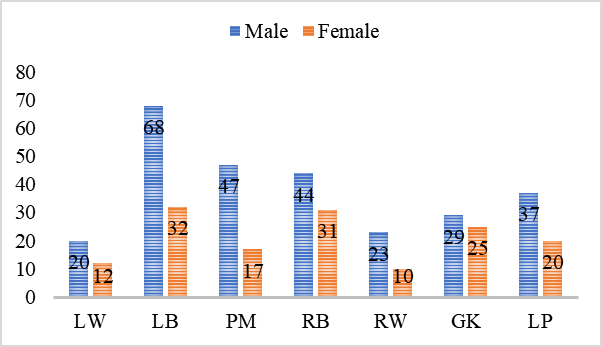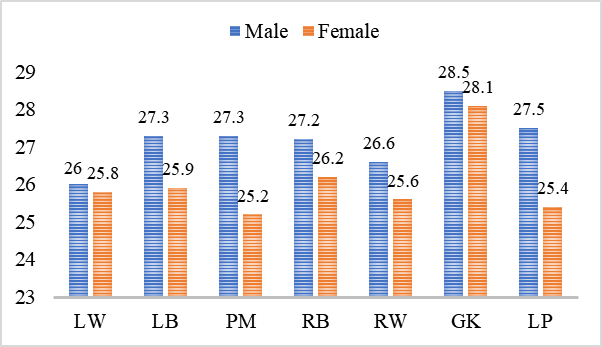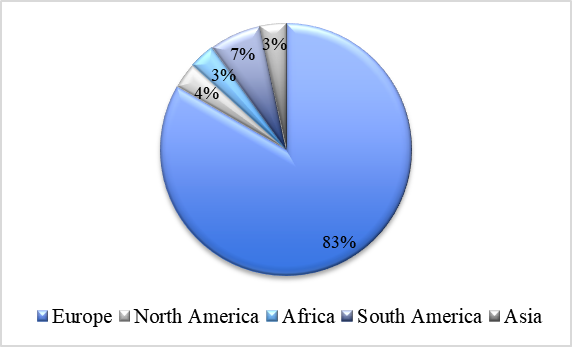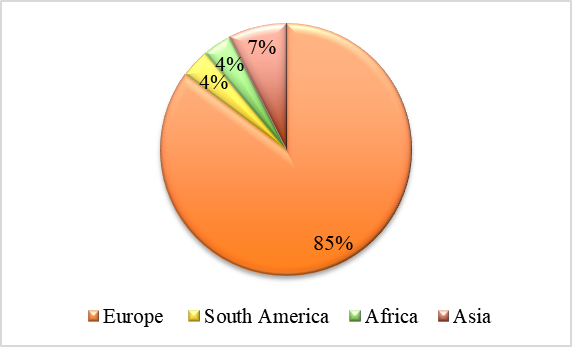Abstract
The phenomenon of migration has always existed, being generally caused by the temptation exerted by richer regions or environments on poorer populations. International migration in our days is materialised under several important forms, and the one that is the topic of this research is labour migration in the field of sport. Sport labour migration implies the movement of those working in the field of sports: athletes, coaches, researchers, media or other staff involved in a diversity of sports like football, basketball, rugby or handball. The movement is recorded between countries, as well as between continents. The migration in sport cannot be explained only by the economic aspects, other reasons being also involved. The phenomenon of migration in sport is in progress in Romania too, a large number of foreign athletes living today on the territory of our country, because they are conducting their sports activity for a Romanian club or team. The aim of this study is to take a closer look at the migration in handball, in Romania. The study will give details about the occurrence of migration and its development over the years until now. Information about the fluctuation of the number of foreign players from year to year, the position occupied by these players on the field, their countries of origin and age will be revealed. A comparison between male and female sectors will also be made.
Keywords: Handballmigrationmenwomen
Introduction
Globalisation is an ongoing worldwide phenomenon, which also leaves its mark on the field of sport around the globe. Athletes, coaches, field specialists leave their home countries to perform in other places, generally where financial investments are substantial.
In Romania, one of the sports that enjoys wide popularity and publicity, and thus the interest of investors, is handball.
Over time, the regulations regarding the international transfer of players to the Romanian handball leagues were first introduced in 2008, when a limitation of the number of foreigners was registered. When playing a Romanian league game, only 3 players of other nationalities could be counted in the same time on the field, and 2 more were allowed to stay on the bench. This rule has undergone changes in 2015, when the value criterion was added, abandoning thus the number limitation imposed before. The measure was thought to increase the level of domestic handball competitions, all the more so as only foreign players coming from the best three leagues, according to the European Handball Federation hierarchy, were allowed to play in the two Romanian leagues.
For the competitive season 2018-2019, a new rule regarding the international transfer of players to the Romanian handball leagues was approved by the Administration Board of the Romanian Handball Federation. Foreign players can play in our domestic leagues only if they have played for their national teams and occupied one of the first 10 places in the last European Championship, last World Championship or Olympic Games, or if they have played with their former teams one of the two recent Final Fours of Champions League or EHF Cup. This measure triggers even more the value of foreign players choosing to come and play handball for a Romanian club, and this way, an even larger window opens for young and talented Romanian handball players.
It is interesting to see how the migration phenomenon will undergo changes in the near future, when the regulations will be changed again. But, for this research, our aim is to examine in detail the migration in the Romanian handball since its beginning until now, including the competitive season 2017-2018.
Problem Statement
The phenomenon of migration has long been debated and started more than 20 years ago, because, in any field, there are always required people who can perform immediately, and these persons are considered important keys to reach the success desired. McNulty and Selmer (2017) gather information about migration in a wide range of fields, including sport, where many examples of successful expatriates are presented. Going more specifically into the field of sport, Elliot and Maguire (2008) made a synthesis in the area of athletic labour migration. It is easy to conclude that the field of sport is strongly “touched” by the phenomenon of migration, and the research reveals that the male side has been more analysed than the female side. The migrating athletes playing different sports are more numerous and more visible than other people involved in sport, and maybe that is why most of the research is dedicated to them. But there are also studies about the migration of coaches (Orlowski, Wicker, & Breuer, 2016).
In local research, the migration phenomenon has also been much debated, however the migration in sport does not have the same exposure as in international research and is actually very poor.
Our interest in the phenomenon of sport migration started a while ago, when two r
Research Questions
Our research aims to answer the questions below:
How many foreigners, male and female handball players, have chosen to play for the two Romanian handball leagues since the appearance of the migration phenomenon?
What is the difference between male and female sectors when talking about migration in the Romanian handball?
From what countries are foreign players and how these countries are spread on the world’s map?
How many foreign players, both male and female, have entered our handball leagues each year?
What was the mean age of foreign players at the time they first came to Romania and what is the mean age based on the position on the field?
Purpose of the Study
The aim of this study is to take a closer look at the migration in handball, in Romania. The study will give details about the occurrence of migration and its development over the years until today. Information about the fluctuation of the number of foreign players from year to year, the position occupied by these players on the field, their countries of origin and age will be revealed. A comparison between male and female sectors will be also made.
Research Methods
The process of data collection has encountered greater difficulties than we expected when we started to take a closer look to the migration phenomenon. The data base existing at the Romanian Handball Federation dates back to 2006 and provides information regarding only the names of foreign players and the teams they signed for when coming to our country. We could not find any data regarding the position occupied on the field by these players, their countries of origin, age or duration of the signed contracts. To find out when the phenomenon appeared in Romania, we had to search the Internet archives and discuss with the managers of clubs existing at that time. We could find with precision that, for the female sector, the first contracts signed with Romanian clubs dated back to 2001. However, regarding the male sector, we could not establish if there were any foreigners playing for a Romanian club before 2006.
After collecting all data using the Romanian Handball Federation database, searching the Internet and discussing with people involved over time in handball, we used the following research methods:
Basic statistical and mathematical calculation
-
Sum – to count the total number of male and female foreign players, the number of continents and countries of origin, the number of foreigners by position occupied on the field, the number of foreign players per year, since the beginning of the migration phenomenon in Romania.
-
Average – to establish the mean age of foreign players at the moment of their arrival in Romania and the mean age by position occupied on the field etc.
-
Percentage – to establish how the distribution of foreign players looks, when talking about the continents they have left to move to Romania.
Graphical representation
Pie chart and clustered column – for a better view of the distributions mentioned above.
Findings
According to our findings, the first female foreign players signed contracts with Romanian clubs in 2001. A number of 3 players, 2 from Ukraine and 1 from Russia, were under contract with the best club in the Romanian league at that time, Oltchim Rm. Vâlcea. Five years later, in 2006, another foreign player was registered at the Romanian Handball Federation by the Rulmentul Brasov Club.
When talking about the male sector, according to our findings, 2006 was the year when the migration in the Romanian handball has started. Back then, 6 players were registered at the Romanian Handball Federation for 4 different clubs in the best Romanian league, all 6 players coming from our Serbian neighbours.
Counting the import over time and including the competitive season 2017-2018, a number of 268 male foreign players were registered with contracts signed with Romanian clubs, while in the female sector, 147 foreigners activated in Romania over time. A distribution of these players’ arrivals to Romania per year is presented in Table
As seen in the table above, the number of male foreigners is closer to be double then the female sector. When examining how many foreigners have joined the Romanian handball leagues each year, we can observe that, for the male side, 2008 was the year with the highest number, 41, while for the female side, 2017 was the year with most entries in our country, 31. It is important to outline that the number of existing foreign players in our domestic leagues is even higher, as the present research provides information only about new players coming to Romania, and does not count those players who already have a number of years spent on our territory.
Not all foreign players decided to play in the best Romanian league for men or women, some of them, for different reasons, finding it interesting to also try the second best league in Romania. As shown in Table
A closer look was also taken regarding the position occupied by foreign players on the field. Figure

For the male sector, the left back (LB) position was occupied by the biggest number of players, 68, followed by the playmaker (PM) position, with 47 foreign players, and the right back (RB) position, 44. There is no surprise in these findings that the 9-m player positions are generally the most wanted positions in which clubs are interested for making transfers. Together, they represent almost 60% of all foreign players that have joined the Romanian handball.
For the female sector, again the left back and right back positions have the biggest number of foreigners, 32 and 31, respectively. The goalkeeper (GK) is the third best represented position by the number of foreign players (25).
Analysing the mean age of foreign handball players activating over time in the Romanian leagues, we can see below (Figure

As regards male players, the findings show that:
goalkeepers (GK) have a mean age of 28.5 years, the highest figure recorded by position;
line players (LP) have a mean age of 27.7 years;
left backs (LB), right backs (RB) and playmakers (PM) have almost the same mean age, 27;
the left and right wings (LW, RW) are the youngest foreign players coming to the Romanian handball, the values being 26 and 26.6, respectively.
As regards female players, the figure above shows that:
the most experienced foreign players are found on the goalkeeper position, with a mean value of 28.1;
on 5 other positions, the mean age calculation shows close values around 25.
Regarding the home countries of foreign players, we could count a wide area of spreading all over the world.
In the Romanian men’s handball, foreign players come from 30 different countries spread over 5 continents. When taking a closer look, we could observe that 133 players from neighbouring countries came to play in Romania: 73 from Serbia, 34 from Hungary and 26 from Ukraine. In percentage, this means 53% of the total number, which can give us a prediction, namely that one of the reasons these players have chosen to come to Romania might be the closer distance to their families back home.
In the Romanian women’s handball, the same three neighbouring countries provide the biggest number of foreigners in our domestic leagues: Serbia 20, Ukraine 19 and Hungary 11. A 34% percentage of the total number of foreign players is represented by these countries. The sum of home countries for players coming to Romania is 27, and these countries are spread over 4 continents.
In Figure


Figure
Conclusion
The appearance of the migration phenomenon was recorded in the Romanian handball in 2001, in the female sector, and in 2006, in the male sector. Since then, an almost double number of male foreign players have been registered under contract with one of the clubs affiliated to the Romanian Handball Federation: 268 men and 147 women.
Analysing in detail the migration in the Romanian handball, the question about the position occupied on the field by these players has raised. The collected data show that, for both male and female sectors, the right back and left back are the positions with the highest number of foreigners registered. For the male sector, left backs, right backs and playmakers represent 60% of the total number of foreigners. When talking about the female sector, besides the two back positions, the goalkeeper position completes the top 3, together representing 59.8% of the total.
When talking about the age of foreigners, the mean age is 26.6. The highest value is registered on the goalkeeper position for both male and female sectors (28.5; 28.1), while the youngest players were registered on the playmaker position for women (25.2) and the left wing position for men (26).
Regarding the home countries of foreign players, we could count a wide area of spreading all over the world. Male handball players come from 5 continents, from 30 countries, 53% being from Serbia, Hungary and Ukraine. Women handball players come from 4 continents, from 27 countries, 34% being from the same three countries: Serbia, Hungary and Ukraine, which might be a sign that one of the things that matter for a player who decides to change country is the distance from their home lands.
It is interesting to see how the migration phenomenon will undergo changes in the near future, when the regulations regarding the international transfer of players to the Romanian handball leagues will be changed again. The foreign selection has tightened and will require higher investments from clubs that want to transfer foreign players, as higher value players are also financially better rated.
References
- Elliot, R., & Maguire, J. (2008). Thinking outside of the box: Exploring a conceptual synthesis for research in the area of athletic labor migration. Sociology of Sports Journal, 25(4), 482-497.
- McNulty, Y., & Selmer, J. (Eds.). (2017). Research handbook of expatriates. Cheltenham, UK, Northampton, MA, USA: Edward Elgar Publishing Limited.
- Orlowski, J., Wicker, P., & Breuer, C. (2016). Labor migration among elite sport coaches: An exploratory study. International Review for the Sociology of Sport. Retrieved from http://journals.sagepub.com/doi/abs/10.1177/1012690216649778
- Vărzaru, C. G., Tudor, V., & Mujea, A. M. (2018). Migration of women athletes to the Romanian Handball League. The European Proceedings of Social & Behavioural Sciences, 36, 240-246. http://dx.doi.org/10.15405/epsbs.2018.03.32
- Vărzaru, C. G., Cojocaru, V., & Igorov, M. (2018). Migration of men athletes to the Romanian Handball League. The European Proceedings of Social & Behavioural Sciences, 36, 271-276. https://dx.doi.org/10.15405/epsbs.2018.03.36
Copyright information

This work is licensed under a Creative Commons Attribution-NonCommercial-NoDerivatives 4.0 International License.
About this article
Publication Date
16 February 2019
Article Doi
eBook ISBN
978-1-80296-054-9
Publisher
Future Academy
Volume
55
Print ISBN (optional)
-
Edition Number
1st Edition
Pages
1-752
Subjects
Sports, sport science, physical education
Cite this article as:
Vărzaru, C., Cojocaru, V., Igorov, M., & Tudor, V. (2019). The Phenomenon Of Migration In The Romanian Handball Since Its Beginning. In V. Grigore, M. Stănescu, M. Stoicescu, & L. Popescu (Eds.), Education and Sports Science in the 21st Century, vol 55. European Proceedings of Social and Behavioural Sciences (pp. 201-208). Future Academy. https://doi.org/10.15405/epsbs.2019.02.25
